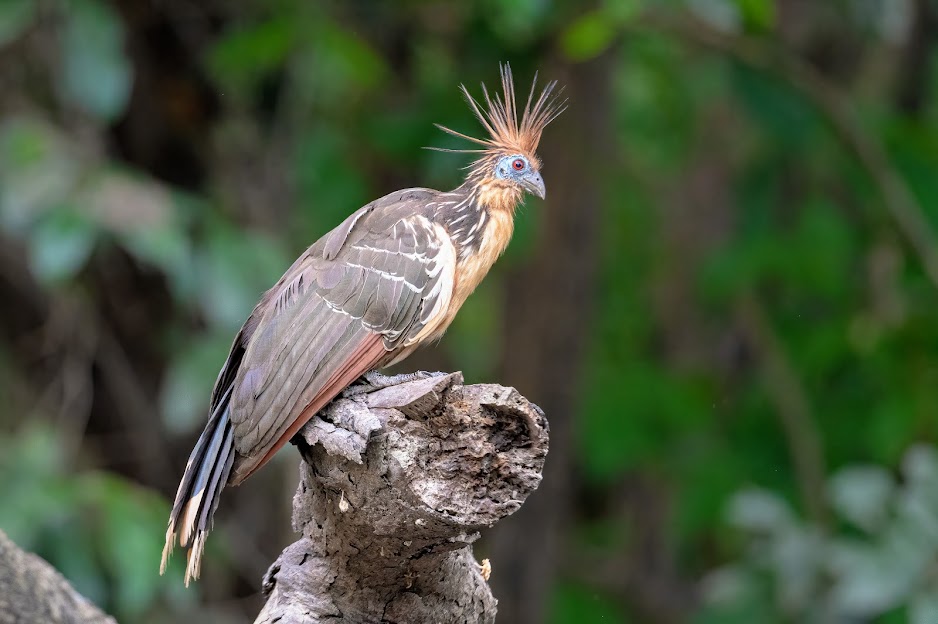
Have you ever birded a place so young that birds still have no names? …
– part 2 –
After I have finished writing this, with a strange mix of emotions I will put the Lynx field guide Birds of Colombia on a bookshelf for the first time, more than half a year after I received it. In my review, I commented that Colombia is one of those countries my dreams are made of, and I think that that sentence got me invited to the Manakin Nature Tours FAM trip of Inirida in Colombian Amazonia…
I had such a bright, childish smile when we entered the boat for the first time, when I felt the fresh river breeze and when we saw our first Orinoco River Dolphin (Inia geoffrensis humboldtiana) right in front of the small harbour of Inirida. Later, we would be seeing dolphins every day. On one hand, dolphins are apex predators and a proof of a preserved ecosystem. On the other hand, in over 250,000 hectares (625,000 acres) of Ramsar wetland around us, their population is estimated to be only 330 individuals. And us? We were plain lucky, so privileged to observe them.
On a previous day, G. said that he dreamt of river dolphins. Anything sexual, I asked. No, I don’t think so, said he.
“In traditional Amazon folklore, at night, a river dolphin becomes a handsome young man who seduces girls, impregnates them, and then returns to the river in the morning to become a dolphin again. This dolphin shapeshifter is called an encantado. The myth has been believed to serve as a way of hiding the incestuous relations which are quite common in some small, isolated communities along the river” (Source: M. A. Cravalho, 1999. “Shameless creatures: An ethnozoology of the Amazon river dolphin”. Ethnology. 38 (1): 47–58.). [After https://en.wikipedia.org/wiki/Amazon_river_dolphin#In_mythology ]
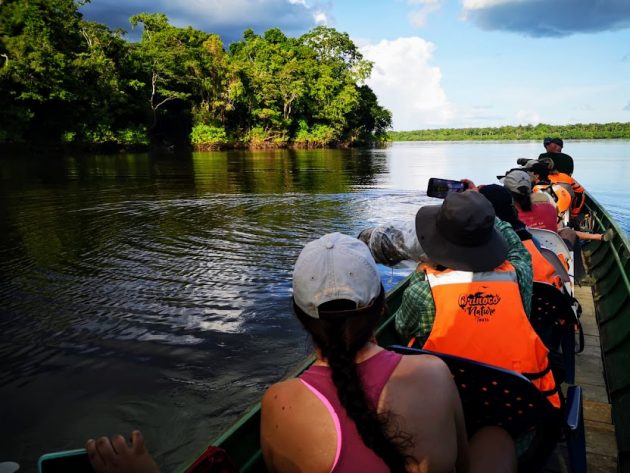 Photo by Juan Carlos
Photo by Juan Carlos
In the late afternoon, the rainy clouds and the low sun beneath them create deep and dramatic shadows in the tree-crowns. We are at the wide mouth of a side river arm, attracted to this site by the dolphins. At first one, then two more, then one more, and altogether some 6 or 7 dolphins were coming to the surface. For a breath of air?
Breathing takes place every 30 to 110 seconds. In the Orinoco, the largest observed groups number 30, but the average size is just above five. The largest congregations are seen in areas with abundant food, and at the mouths of rivers.
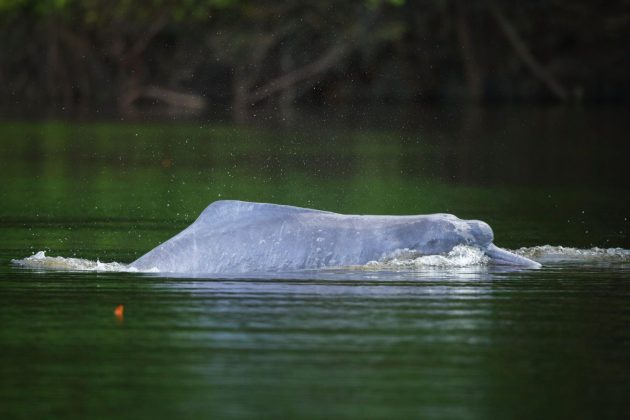 When they surface, the tips of the snout, biosonar “melon” and dorsal fins appear simultaneously, the tail rarely showing before diving. Photo by Paul Maury.
When they surface, the tips of the snout, biosonar “melon” and dorsal fins appear simultaneously, the tail rarely showing before diving. Photo by Paul Maury.
We occasionally heard their loud snorting, while their movements were relaxed and rush-free. Am I over-confident in my thinking that we were so interesting that they were investigating us for a good half an hour, until we moved further upriver? Other than that, I have no explanation what were they doing.
Adult males reach an average length of 2.32 metres (7.6 ft) and weight of 154 kilograms (340 lb). Despite their tiny eyes, they seem to have good eyesight in and out of the water.
Their presence around our boat made us quiet, almost whispering, like being in a church or a museum. I felt special, as if being allowed to observe some ancient ritual whose meaning I do not understand, but I felt humbled, and bursting with joy at the same time.
From there, we entered a side tributary full of Ringed and Amazon Kingfishers, with Chestnut-fronted and Scarlet Macaws in flight… and then the noise: groans, croaks and grunts… and the smell… of this 65 million years old species, so old that the last dinosaurs must have fed on them!
We sailed right into a group of more than a dozen Hoatzins (cover photo, by Tyler Ficker) with their orange mohawks and blue facial skin. Most of them were clumsily retreating deeper into vegetation, but some were startled, standing where we found them, and allowing for good, close looks.
“The Hoatzin is a folivore – it eats the leaves (and to a lesser degree of fruits and flowers) of the plants that grow in the marshy and riverine habitats. One of this species’ many peculiarities is that it has a digestive system unique amongst birds: Hoatzins use bacterial fermentation in the front part of the gut to break down the vegetable material they consume, much as cattle and other ruminants do. Because of that, the bird has a manure-like odour and is only hunted by humans for food in times of dire need” [Source].
Hoatzin is one of the species I always dreamed to see, and then I forgot they are possible on this tour, so I didn’t expect them! I was utterly surprised with their presence, much more than they were with mine. The afternoon birds also included Capped Heron, Mealy Parrot, Drab Water Tyrant, Amazonian Tyrannulet, Green-tailed Jacamar and more than 40 Sand-colored Nighthawks.
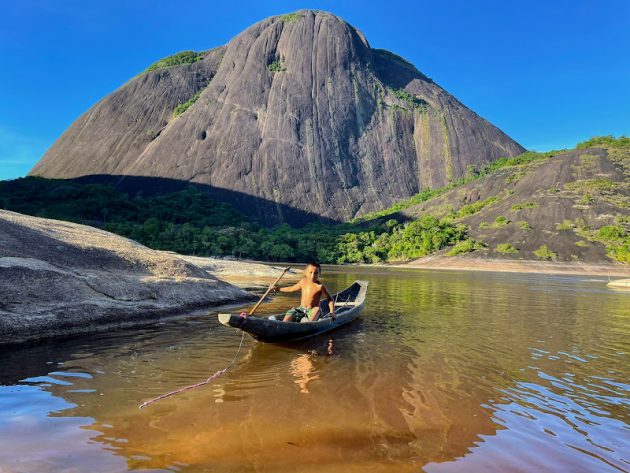 Cerros de Mavecure, photo by Juan Carlos
Cerros de Mavecure, photo by Juan Carlos
The final stretch of our Amazonia journey led us to the Cerros de Mavecure, a sacred place for indigenous people—a place where men could connect with their gods. Made famous by the Oscar-nominated film “Embrace of the Serpent”, these three granitic monoliths rise on both banks of the Inirida River, the highest to more than 700 metres (2,300 ft). Actually, they are all the same, single rock, the westernmost piece of the Guyana Shield geological formation, carved into two by the river and further rounded by rains. Located within a Puinave indigenous reserve, these remnants of ancient parent-rock are some of the oldest geological formations in all of South America. We found Black-collared Swallows breeding in cracks among the lower riverside rocks.
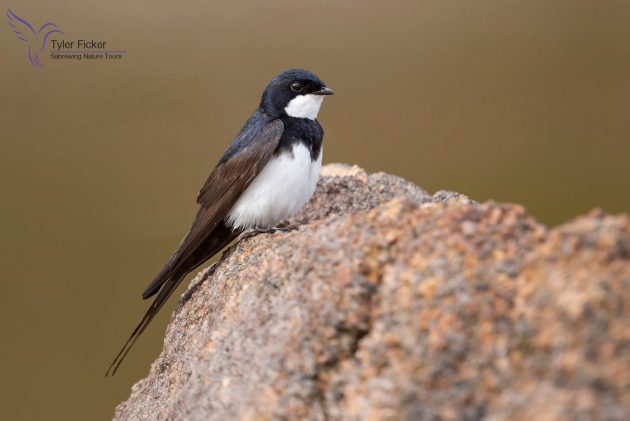 Black-collared Swallow by Tyler Ficker
Black-collared Swallow by Tyler Ficker
“Lord John came abreast of me, however, and his face was more grave than was his wont. He had his Zeiss glasses in his hand. ‘I focused it before it got over the trees,’ said he. ‘I won’t undertake to say what it was, but I’ll risk my reputation as a sportsman that it wasn’t any bird that ever I clapped eyes on in my life.’” This is how 100 years ago Sir Arthur Conan Doyle described a particular sighting over the top of one of these tepui mountains in his 1912 novel The Lost World. Instead of a Pterodactyl, we had one rare Orange-breasted Falcon by the mountain top, which greeted us in the scope-view.
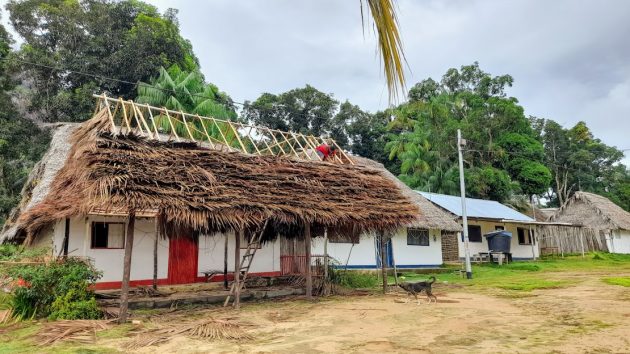
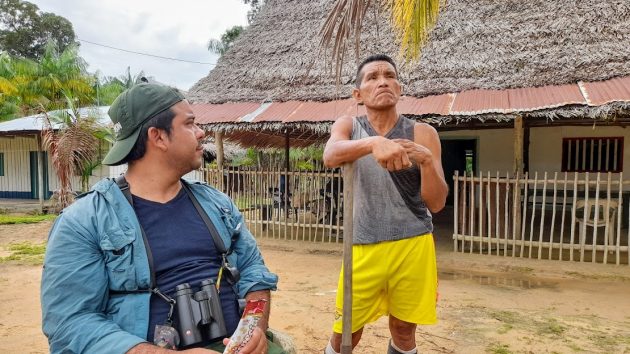 Indigenous community of El Remanso, right underneath the imposing monoliths of Cerros de Mavecure. Left to right: my guide Edson Moroni and the local shop keeper Daniel Luis.
Indigenous community of El Remanso, right underneath the imposing monoliths of Cerros de Mavecure. Left to right: my guide Edson Moroni and the local shop keeper Daniel Luis.
After another great fish lunch by the white-sand beach, many took a swim (with a dolphin present) at a place that makes you drowsy and reluctant to leave… We even had a mock mutiny, asking the tour leader to stay there overnight at least. Yet, we had a good two hours or almost 50 kilometres by 75 horse-powered speedboat to reach Inirida at sunset.
En route we saw even more dolphins, a Giant Otter (dolphins sometimes associate with Giant Otters, Pteronura brasiliensis, to hunt by gathering and attacking fish at the same time) and a group of half a dozen rare (lifer for our tour-leader!) and near-endemic Golden-backed Uakari monkeys (Cacajao melanocephalus).
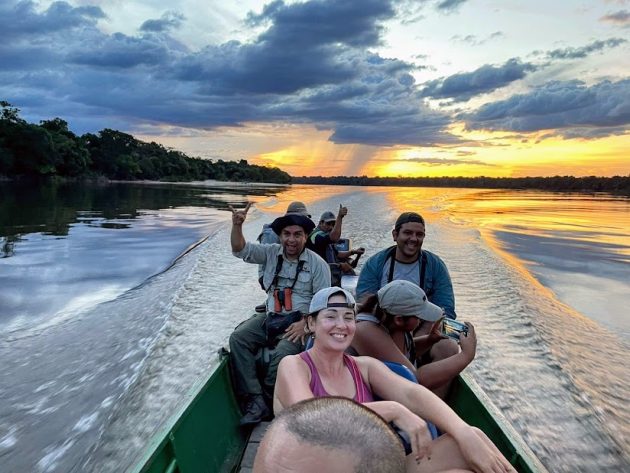 Photo by Juan Carlos
Photo by Juan Carlos
And then there was an odd moment, when the skipper slowed down and we started searching the tree-crowns for monkeys, or birds… nothing, then the skipper manoeuvred around to collect a single beer can floating in the river. There is no rubbish floating down the Inirida River, nor decorating its banks. Nor will there be, as our skipper has assured us.
– end of part 2 –
In the next post 3: practicalities of birding Inirida.
I was on a new birding tour well organised by Manakin Nature Tours and supported by ProColombia. As air carriers, to Bogota I used AirEuropa and later, to Inirida, Satena Air. In Inirida, we stayed at a comfortable Fuente del Guania Hotel de Lujo, nestled in the deep shade of tall tree-crowns.
Find the part 1 here: https://www.10000birds.com/birding-inirida-colombia-a-forest-so-young-that-birds-still-have-no-names-part-1.htm
Cover photo: Hoatzin, by Tyler Ficker


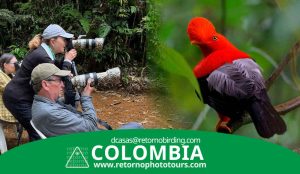


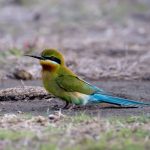
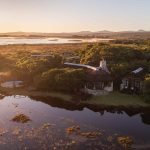
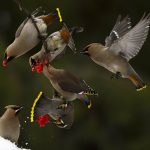
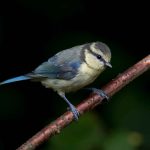
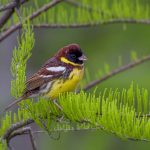
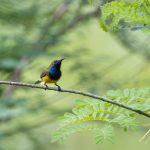
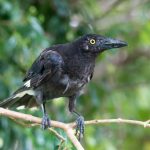
Wow! What a great experience. I will immediately begin my list of which countries my dreams are made of, in the hopes of a similar invitation.
It actually helps to keep you focused